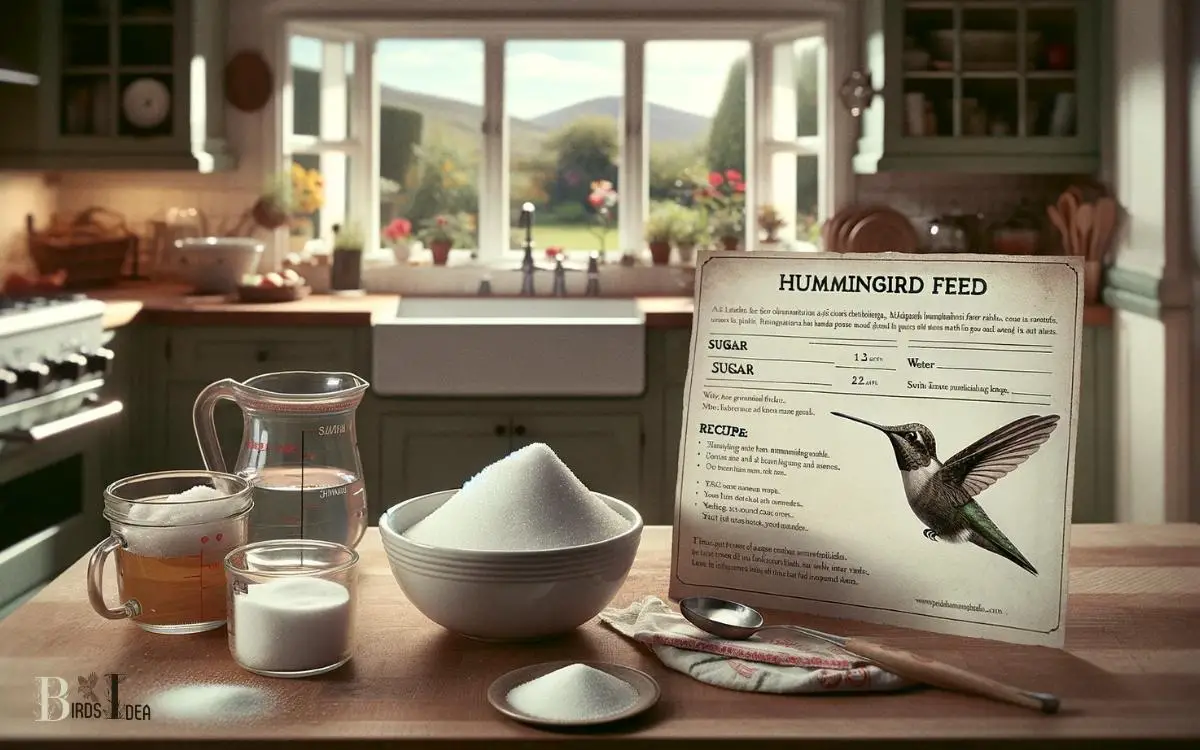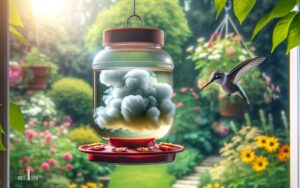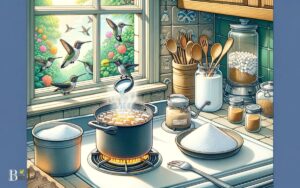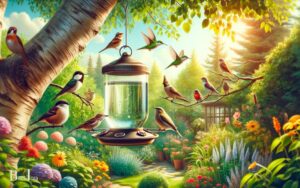What Is the Recipe for Hummingbird Feed? Discover!
To make hummingbird feed, mix 1 part white granulated sugar with 4 parts water until the sugar is completely dissolved. Boil the mixture for 2 minutes, then let it cool before serving.
Hummingbird feed, essentially a sugar-water nectar, is designed to mimic the natural nectar found in flowers. The 1-to-4 ratio of sugar to water provides the calories hummingbirds need for energy.
Here’s a simple breakdown:
Creating hummingbird feed is a simple way to attract these vibrant birds and support their high-energy lifestyle.

Key Takeaway
Understanding Hummingbird Diet
Understanding the hummingbird diet is crucial for providing these tiny birds with the necessary nutrients for their high-energy lifestyles.
Hummingbirds primarily feed on flower nectar, which provides them with the carbohydrates essential for their rapid metabolism.
In addition to nectar, they also consume insects and spiders for the protein and fats vital for their overall health and energy needs.
As individuals who desire to serve these remarkable creatures, it is important to offer a balanced diet that mimics their natural food sources.
This can be achieved by providing a homemade nectar solution made of sugar and water, as well as offering protein sources such as small insects or commercially available fruit fly or mealworm feeders.
By understanding and catering to the hummingbird diet, we can contribute to their well-being and enable them to thrive in our surroundings.
Essential Ingredients for Hummingbird Nectar
The recipe for hummingbird nectar consists of a simple mixture of sugar and water.
To prepare the essential ingredient for attracting these delightful creatures, you will need:
- Granulated white sugar
- Fresh, clean water
- A pot for boiling water
- A spoon for stirring
These ingredients are easily accessible and affordable, making it convenient for those who wish to serve hummingbirds in their vicinity.
By using these simple components, you can create a nectar solution that provides the necessary energy for these tiny birds to thrive.
Additionally, this straightforward recipe ensures that the nectar is free from harmful additives, prioritizing the well-being of the hummingbirds.
Now, let’s dive into the subsequent section to explore the perfect nectar-to-water ratio for this delightful concoction.
The Perfect Nectar-to-Water Ratio
When preparing hummingbird nectar, achieving the perfect nectar-to-water ratio is crucial. This ratio is influenced by factors such as the sweetness preference of hummingbirds, their feeding behavior, and the importance of using clean, fresh water.
Understanding these points will help ensure that the nectar is well-balanced and attractive to hummingbirds without posing any harm to them.
Nectar Sweetness Preference
To achieve the perfect nectar-to-water ratio for hummingbird feed, it is essential to consider their preference for sweetness.
Hummingbirds are attracted to sweet nectar, and adjusting the sweetness of the nectar can help in attracting them to feeders.
Here are some key points to consider when determining the sweetness preference for hummingbird nectar:
- Natural sweetness: Hummingbirds are naturally drawn to the sweetness of flower nectar.
- Avoid artificial sweeteners: Artificial sweeteners can be harmful to hummingbirds and should be avoided.
- Ideal sugar concentration: The ideal nectar-to-water ratio is 1:4, which equates to a 20% sugar solution.
- Taste testing: Observing hummingbird behavior and consumption can help determine the optimal sweetness level.
Understanding the sweetness preference of hummingbirds is crucial in creating a nectar solution that attracts and benefits these delightful creatures.
Moving on to the subsequent section about hummingbird feeding behavior…
Hummingbird Feeding Behavior
Given the hummingbird’s preference for sweetness, achieving the perfect nectar-to-water ratio is crucial in catering to their feeding behavior.
Hummingbirds have high metabolic rates and need to consume large amounts of nectar to meet their energy requirements.
The ideal nectar solution mimics natural flower nectar, with a sugar concentration of around 20-25%.
This equates to a ratio of 1 part sugar to 4 parts water. An accurate nectar-to-water ratio ensures that the solution provides the necessary energy while also preventing the birds from becoming dehydrated.
Offering a well-balanced nectar solution is essential for supporting the health and vitality of these delicate creatures.
By understanding and implementing the perfect nectar-to-water ratio, individuals can effectively contribute to the well-being of hummingbirds in their care.
Water for Nectar
The ideal nectar solution for hummingbirds requires a sugar concentration of around 20-25%, which translates to a ratio of 1 part sugar to 4 parts water, ensuring the necessary energy supply while preventing dehydration.
When preparing the nectar, it is important to consider the following:
- Use only refined white sugar as other sweeteners can be harmful to hummingbirds.
- Boil the water first to remove impurities and then add the sugar, stirring until completely dissolved.
- Let the nectar cool to room temperature before filling the feeders to avoid potential harm to the birds.
- Change the nectar every 2-3 days, especially in hot weather, to prevent fermentation and the growth of harmful molds.
Understanding the perfect nectar-to-water ratio is crucial for providing hummingbirds with a healthy and beneficial source of energy.
Now, let’s move on to the steps for making homemade hummingbird feed.
Making Homemade Hummingbird Feed
Creating homemade hummingbird feed involves mixing sugar and water in specific proportions to provide a nourishing and energy-rich solution for these tiny birds.
To make the feed, start by boiling 4 parts of water and then stir in 1 part granulated white sugar until it dissolves. Once the solution cools, it is ready to be poured into clean hummingbird feeders.
It’s important to change the nectar every 2-3 days, especially in hot weather, to prevent fermentation and the growth of harmful bacteria.
Clean the feeder with hot water and a small brush each time you refill it to maintain the health of the hummingbirds.
By following these simple steps, you can ensure that the hummingbirds visiting your garden are provided with a safe and nutritious source of food.
Best Practices for Feeding Hummingbirds
To ensure the health and well-being of hummingbirds, it is essential to adhere to best practices for feeding them, particularly by maintaining a clean and fresh supply of nectar in their feeders.
When feeding hummingbirds, consider the following best practices:
- Regular Cleaning: Clean the feeders at least once a week with hot water and a brush to prevent mold and bacteria buildup.
- Fresh Nectar: Replace the nectar every 2-3 days, especially in warm weather, to prevent fermentation and spoilage.
- Proper Placement: Hang the feeders in shaded areas to keep the nectar fresh for a longer time and prevent overheating.
- Avoid Red Dye: Refrain from using red dye in the nectar as it can be harmful to hummingbirds.
Adhering to these best practices will help ensure that the hummingbirds visiting your feeders remain healthy and well-nourished. Now, let’s delve into tips for maintaining hummingbird feeders.
Tips for Maintaining Hummingbird Feeders
Maintaining proper hygiene and cleanliness of hummingbird feeders is crucial to ensuring the health and well-being of these delicate birds.
To maintain a healthy environment for the hummingbirds, it is essential to clean the feeders at least every three to four days, especially in warm weather when nectar can spoil more quickly.
Use a solution of one-part white vinegar to four parts water for thorough cleaning, ensuring all parts of the feeder are rinsed well and completely dry before refilling.
Additionally, placing the feeders in shaded areas can help prevent the nectar from spoiling too quickly.
Regularly inspect the feeders for any signs of wear or damage, and replace any worn parts to prevent potential hazards to the hummingbirds.
By following these maintenance tips, you can ensure a safe and inviting environment for these beautiful birds.
What Is the Best Recipe for Hummingbird Feed?
Looking to attract and nourish hummingbirds? The best recipe for feeding hummingbirds requires a simple blend of sugar and water. Mix one part white sugar with four parts water, boil the mixture until the sugar dissolves, and let it cool. Then, fill your hummingbird feeders with this sweet concoction, ensuring their vitality and satisfaction.
Troubleshooting Common Hummingbird Feed Issues
Addressing common hummingbird feed issues requires a systematic approach to identifying and resolving potential problems.
When troubleshooting, consider the following:
- Check for Spoilage: Ensure the nectar is not spoiled or fermented, as this can deter hummingbirds from feeding.
- Monitor the Feeder Position: Verify that the feeder is not in direct sunlight, as this can cause the nectar to spoil more quickly.
- Inspect for Insects: Regularly clean the feeder to prevent the buildup of mold and the attraction of insects.
- Evaluate Nectar Concentration: If hummingbirds are not visiting the feeder, adjust the nectar concentration to ensure it aligns with their preferences.
Conclusion
Creating a homemade hummingbird feed requires understanding the bird’s diet, using essential ingredients in the right ratio, and following specific steps.
Best practices for feeding and maintaining feeders can ensure the well-being of these delicate birds.
Troubleshooting common issues such as mold or ants is essential for a successful feeding experience.
As the saying goes, “The early bird catches the worm,” and providing the perfect nectar can attract these beautiful creatures to your garden.






